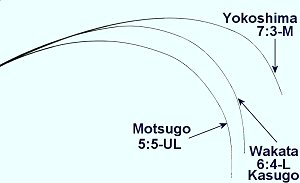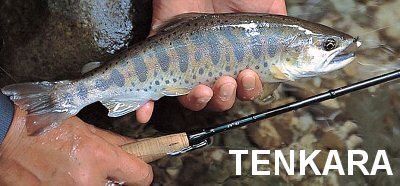
The Art of Tenkara Fishing.

What is Tenkara rod?
Tenkara Action Index
How to connect line to the rod? Several helpful Tips Tenkara fishing
If rod sections get stuck at a joint?
Several Top Ways to Break a Tenkara Rod
How to land a fish?
Take a good care of your rod
What makes Tenkara fishing a popular competitive method of fly-fishing?
The simplicity, accuracy in casting and extremely light-weight are the main advantages of Tenkara fishing.
- Widely used
- Delicate presentation
- Extreme accuracy
- Using lightest of tackle
- The simplicity
- Challenging, Pleasure, Fan
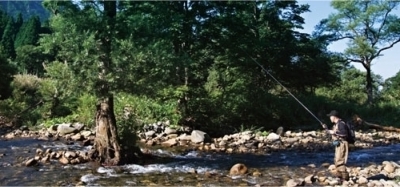
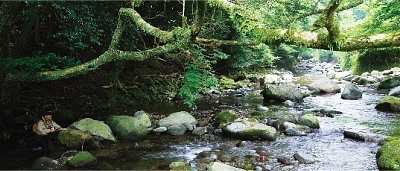
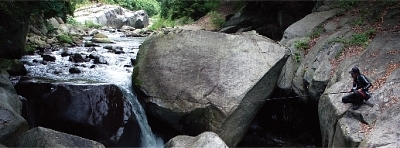

Using ultra-light tackle increase the challenge and satisfaction in playing fish especially when you land it.

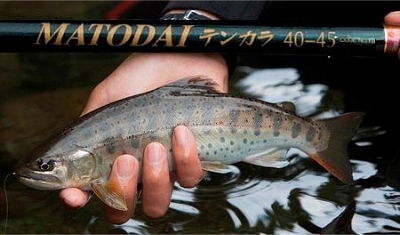
Tenkara Rods Light 6:4 Action
Tenkara Rods Medium-Light 7:3 Action
Tenkara Rods Medium 8:2 Action
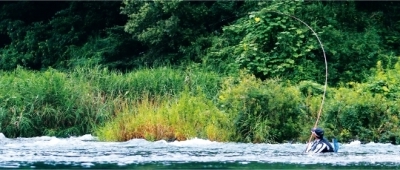
Modern Tenkara rods are very portable telescopic rods, length from 9 to 16.5 ft, can collapse to 41 - 90cm, great for travel and transportation, excellent for backpacking, touring kayakers and small to medium size stream fishing, where it's rarely necessary to cast very far. They are very lightweight and incredibly strong with very sensitive and soft action, with a very smooth curve and bending action through the entire rod. This allows the angler easy manipulate the fly, to feel the slightest fish bites. They also allow getting you in hard to reach places where other rods can't with the greatest accuracy. The longer the rod the more advantage anglers get when casting very light lines with fly, playing fish, give you better leverage over the line and the fly.
Back to top
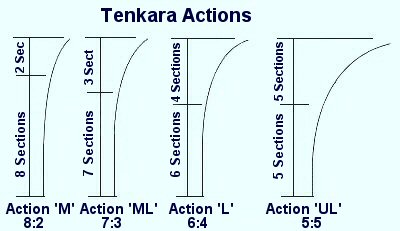
- 'UL' - Ultra Light - 5:5 indicates 5 bottom sections are stiffer and 5 tip sections bend more easily. Rod feel more delicate when casting because of an extra flexibility, it is great for slower casting and can hold smaller fish up to 1kg, but landing a larger fish will be more challenging using this rod.
- 'L' - Light - 6:4 means 6 bottom parts are stiffer and 4 tip sections more flexible. Rods are more sensitive and feel more precise when casting, it is great and slightly easier for a larger fish up to 2 kg.
- 'ML' - Medium Light - 7:3 indicates 7 bottom sections are stiffer and 3 tip sections more flexible. Rods are stiffer, have more precise and more powerful when casting, it is great for a larger fish up to 3kg.
- 'M' - Medium - 8:2 means 8 bottom parts are stiffer and 2 tip sections more flexible. Rods are the stiffest and fastest or are pursuing larger fish and want the rod to help them land the big fish, up to 4 kg.
You can choose the length of the rod based on the places where you will fish. Longer length allows you to fish in a wide area of the stream, on the other side of the stream or allow you to reach a longer distance without changing the fishing spot. Longer rods will give you better leverage over the line and the fly and require smaller movement by angler to set the hook for effective striking. Using a longer rod will also give you a huge advantage when playing fish, keeping it away from snags.
The line is attached directly to the tip of the rod, and tippet is attached to the end of the Tenkara line. Traditional Tenkara lines are furled, it is necessary for casting the weightless flies forward.
Back to top
How to connect line to the rod
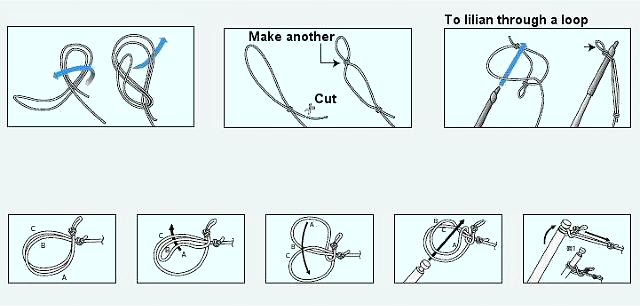

A single overhand loop on the braid lilian material connected to the rod's tip is all you need.
Next make a double knot on the fishing line.
After that put the loop over the braid lilian between the rod's tip and the single overhand loop and tide the line.
Several helpful Tips
Never lift your catch, don't raise your rod, keep it low at about 45 degrees or even less to avoid breaking tip or top sections. Always play with the fish and use landing net to land it. Always extend and insert telescopic sections very gently, try do not extend them too forcibly, try to keep it off the ground to avoid dirt getting into the joints. Never rush, your catch is still waiting for you, always think twice and you will not step on the rod, fall on the rod, run over the rod with a car, walk through the woods or brush with an extended rod or hit the rod's tip with a tree branch or rock.
Wipe it clean with a cloth before taking it down so you don't jam dirt into the joint, rinse rod with freshwater after using it in saltwater as soon as you can. Always remember to take a good care of your rods and they will work for you for a very long time and will bring you large amount of catches and a huge amount of great emotions. More great emotions - longer and healthier is your life.
Back to top
You should open and close telescopic rod with a special care, always keep control of the rod sections.
Tenkara rods can easily take even very heavy load, they are very strong and durable but they need to be handled with cared too. They usually don't break while fighting the fish but they could break while they are being closed without special care. Opening and closing these rods must be done very carefully and gently, no sideway pressure should be applied to the rod while closing it.
Opening Tenkara Rod.
Telescopic rods are very simple to open, but there are a couple of points to keep in mind to simplify the process and avoid damaging the rod:
- Remove the plug at the end of the rod and expose the tip of the rod with a lilian string by tilting the rod a little.
- Expose the section with the braided string first and attach the line to the tip.
- Pull the tip and other sections out sliding each part between the fingers.
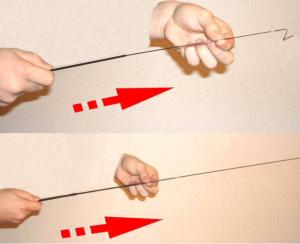
Closing Tenkara Rod.
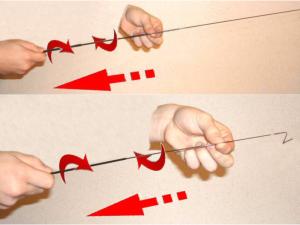
Back to top
If rod sections get stuck at a joint:
The most frustrating things that can happen to a telescopic fishing rod (after braking) is to become jammed at a joint. Occasionally this can happen due to dirt/mud/sand in the joint but the main cause of the joints fixed too tightly is extending the rod too forcibly.
Prevention is better than cure: try do not extend the rod too forcibly, try to keep your rod off the ground at all times to avoid dirt getting into the joints. Wipe it clean with a cloth before taking it down so you don't jam dirt into the joint. If you've been using it in saltwater give it a quick rinse with freshwater as soon after use as you can. Its a good idea to put a protectant like WD-40, Tackle Guard or a silicon lube on the joints.
When it happens there are several techniques to unstick the sucker.
-
A.

B. Pour hot water on large side of the joint as close to the joint as you can to rapidly expand it. Then after a few seconds try twisting or pushing the small side of the joint back down. Its best if you can do this under a tap where the water starts off cold then gets progressively warmer over a few seconds as this reduces the risk of stress cracks developing in the joint.
C. If the hot water technique fails try the next step up. Do the same as above but put ice on the small side of the joint to shrink it. This is easiest if you get some ice from your freezer place it on a cloth or towel and then wrap that around the rod and hold it while you heat the other side with hot water.
D. Try a penetrating lubricant like WD-40, CRC or Tackle Guard. Leave the joint to soak for an hour or two and then try gently to take the rod down.
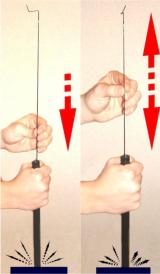
Back to top
Several Top Ways to Break a Tenkara Rod
Rod maintenance has nothing to do with rod breakage. Anglers will always find ways to break their rods, starting from regular (car doors) to very stupid (standing on it) or while fighting a huge fish.
-
1. Step on the rod, fall on the rod, or run over the rod with a car.
One must be aware of where the rod is at all times and be especially aware of others nearby who may not see where you laid your rod. An extended rod that falls down unto the ground or other immovable object can break or be weakened by impact.
2. Slam a trunk or a car door shut with the rod stuck in it or stick the rod out the electric car window and then close the window.
Always check if anything stuck from the trunk or car door or car window before closing it. Prevention is better than loss.
3. Leaning an extended rod against a car, tree, rock or any other hard surface.
Striking the a rod section on an immoveable hard object will either brake it or weaken the integrity of the rod structure to the point that it later breaks under a normal load. Always lean a rod against a car with closed front doors.
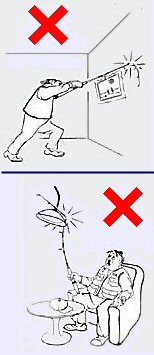
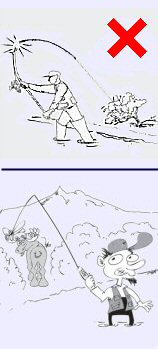
-
4. Walk through the woods or brush with an extended rod.
Allowing the tip to hit an immovable object like a tree, tree branch, or rock while moving forward or backward (backward if you carry the extended rod with the handle forward) will inevitably end in a broken tip section.
5. Casting the rod without first clearing it of overhead branches or other obstacles (like the underside of a bridge).
6. Try to free a snagged fly with the rod.
Always pull on the line and never with the rod.
7. Try to remove an overhead snagged fly or line without first removing the line from a nested rod.
Anytime a fly or line is stuck in an underwater snag like a submerged rock, tree branch, heavy weeds, or streamside vegetation, it should be freed by carefully grasping the line and pulling steadily while making sure there is no more than a slight bend in the rod. A snagged fly may take up to 10lbs or more steady pressure to pull free. If possible, it is best to nest the rod sections completely, detach the line from the lillian, put the rod in a safe place and then work on removing the snagged line or fly.
-
8. Connect the line to the lillian with the tip section of the rod with any part of the tip except the lillian outside the nested rod.
Even slight pressure side to side on a partially nested tip section may cause it to snap.

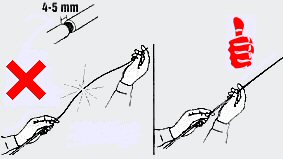
-
9. Extend the rod by whipping the sections out of the rod with centrifugal force rather by than by slowly extending each section until snug starting with the tip and working toward the base.
Anytime the rod sections are extended with great force there is a risk that one or more sections may become permanently stuck so tightly that only breakage can release them.
-
10. Point the rod directly at a heavy fish or snag and pull the rod backward.
11. Drag a heavy fish to the net, hand, or bank with the extended rod arced behind the fisher and not straight up.
12. Let the large fish land on the rod and break it during the struggle.
An excessive rod angle (usually caused by the extended rod handle angled backward rather than straight up) will inevitably cause the weakest or most strained section of the rod to break. Beach a large fish by backing up with the rod handle in your hand held at a forward angle of no greater than 90 degrees and preferably in the 45 to 60 degree range. This includes having a guide or friend netting a fish too heavy to bring in with rod alone. After a heavy fish is sufficiently subdued, if alone, it is best to bring in a heavy fish by grabbing the line, laying the rod on the ground in a safe place, and then pulling the line in hand over hand. A really big fish can then be netted, unhooked and released or scooped onto the bank with a free hand. This particularly true of fish weighing 50 to more than 100 percent of the tippet strength.
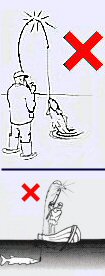
Back to top
How to land a fish
Needless to say that landing a small fish is very straightforward with rods, just raise it and slide the fish into the landing net range. Catching bigger fish, fighting the large one is very enjoyable, always a challenge requiring a lot of patience and knowledge especially with the light tackle. Of course it's a lot of fun.
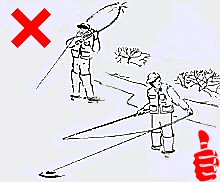
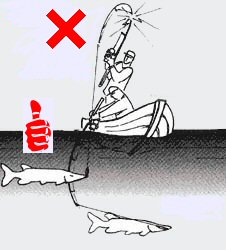
Another technique that works with longer rods is to extend the rod all the way out past the fish so that the fish is between you and the tip of the rod. If you apply a little pressure on the line in the direction opposite to where you are, the fish will start struggling and moving towards you which is exactly what you want to happen. You might also keep the tip of the rod right above the fish to achieve the same result.
Back to top
Take a good care of your rod.
What should or should not be done to keep our fishing tackle in good shape and ensure many years of fishing enjoyment?

This is one of the most common causes of breakage and is 100% angler-caused.
2. Do not use force to open or close telescopic rod.
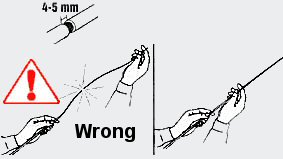
4. Be extra careful when getting your fishing rod out of the car, especially if it is a graphite rod. Too many people break their rod on the car door.
5. Always avoid extreme temperatures.
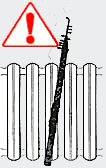
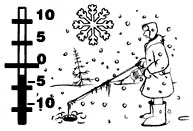
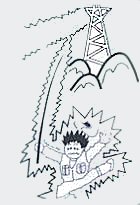
8. If you seal up the damp or sordid fishing rod, the moisture will possibly cause the bubbling or scaling off of lacquer. To prevent this, always rub off the moisture on fishing rod and keep it in a ventilated place. Never store a rod in its tube. Humidity can cause the moisture.
9. Always rub off the moisture, salt and dirt before storage.
10.Never use brush, toothpaste, gasoline, dope and other organic substances to clean the fishing rod; it may create damage to rod surface and even the rod itself. Don't clean the rod by steel brush.


Always remember to take a good care of your rods and they will work for you for a very long time and will bring you large amount of catches and a huge amount of great emotions. More great emotions - longer and healthier is your life.
Back to top



